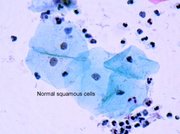A 40-year-old woman presented with a 5-year history of dizzy spells. They did not occur very often; the most recent two spells occurred during the preceding 5 weeks. During these spells, her balance was poor, she became hot, sweaty, and nauseous, and she felt that she might black out. Her initial spells lasted approximately 15 to 20 minutes; the spells were relieved by vomiting. Between spells, she had difficulty standing.
Approximately 12 years earlier, she had hit her nose on a hardwood floor. As a result of this accident, her nose was fractured and she began to experience a problem with aural fullness in the left ear. Eleven years prior to presentation, she developed tinnitus in the left ear. She characterized it as a constant sound similar to a seashell-type noise. Her only other hearing symptom was a vibration or echo in the left ear that primarily occurred when she was in the shower. She also had a 2-year history of constant aural fullness in the left ear.
Clinical examination revealed a scarred left tympanic membrane that moved well on pneumatic otoscopy. Paresthesias of the second and third divisions of the trigeminal nerve on the left were present, and there was tenderness on palpation of the left nuchal area where the muscle attaches at the occiput.
Electronystagmography elicited no spontaneous or positional nystagmus. The alternate binauralbithermal stimulus yielded a 35% reduced vestibular response left and a 29% directional preponderance right. The simultaneous binaural
bithermal test elicited a type 2 response, confirming that the left side was the source of the dizziness. Findings on audiology and speech testing were normal for both ears, and there was no difference between ears. Acoustic immittance was normal in the left ear.
Findings on magnetic resonance imaging of the skull base were compatible with fibrous dysplasia. A biopsy of the temporal bone squama was positive for fibrous dysplasia.
From Neurotologic Associates, P.C., New York City.
COPYRIGHT 2004 Medquest Communications, LLC
COPYRIGHT 2004 Gale Group



